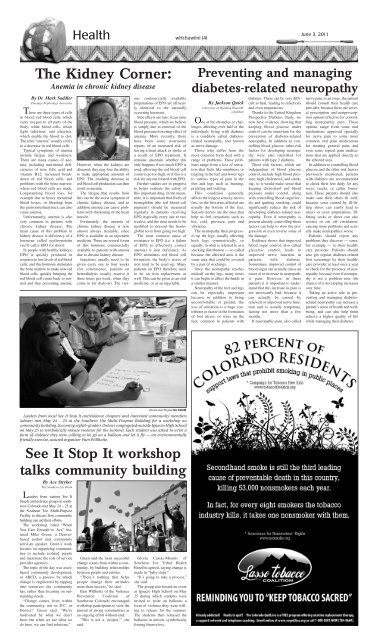June 3, 2011 - Southern Ute Indian Tribe
June 3, 2011 - Southern Ute Indian Tribe
June 3, 2011 - Southern Ute Indian Tribe
You also want an ePaper? Increase the reach of your titles
YUMPU automatically turns print PDFs into web optimized ePapers that Google loves.
<strong>June</strong> 3, <strong>2011</strong><br />
Health wHchuwiini (4)<br />
The Kidney Corner:<br />
Anemia in chronic kidney disease<br />
By Dr. Mark Saddler<br />
Durango Nephrology Associates<br />
There are three types of cells<br />
in blood: red blood cells, which<br />
carry oxygen to all parts of the<br />
body; white blood cells, which<br />
fight infection; and platelets,<br />
which enable the blood to clot.<br />
The term “anemia” usually refers<br />
to a decrease in red blood cells.<br />
Typical symptoms of anemia<br />
include fatigue and weakness.<br />
There are many causes of anemia,<br />
including nutritional deficiencies<br />
of iron, folic acid and<br />
vitamin B12; increased breakdown<br />
of red blood cells; and<br />
problems with the bone marrow,<br />
where red blood cells are made.<br />
Longstanding blood loss, for<br />
example due to heavy menstrual<br />
blood losses, or bleeding from<br />
the gastrointestinal tract, can also<br />
cause anemia.<br />
Unfortunately, anemia is also<br />
very common in patients with<br />
chronic kidney disease. The<br />
main cause of this problem in<br />
kidney disease is deficiency of a<br />
hormone called erythropoietin<br />
(we’ll call it EPO for short).<br />
In people with healthy kidneys,<br />
EPO is quickly produced in<br />
response to low levels of red blood<br />
cells, and this hormone stimulates<br />
the bone marrow to make new red<br />
blood cells, quickly bringing the<br />
red blood cell count back to normal<br />
and thus preventing anemia.<br />
However, when the kidneys are<br />
diseased, they may lose the ability<br />
to make appropriate amounts of<br />
EPO. The resulting decrease in<br />
red blood cell production can then<br />
result in anemia.<br />
The fatigue that results from<br />
this can be the worst symptom of<br />
chronic kidney disease, and in<br />
addition anemia can cause problems<br />
with thickening of the heart<br />
muscle.<br />
Fortunately, the anemia of<br />
chronic kidney disease is now<br />
almost always treatable, since<br />
EPO is available as an injectable<br />
medicine. There are several forms<br />
of this hormone commercially<br />
available to patients with anemia<br />
due to chronic kidney disease.<br />
Injections usually need to be<br />
given every one to four weeks<br />
(for convenience, patients on<br />
hemodialysis usually receive it<br />
three times per week, when they<br />
come in for dialysis). The various<br />
commercially available<br />
preparations of EPO are all nearly<br />
identical to the naturally<br />
occurring hormone.<br />
Side effects are rare; it can raise<br />
blood pressure, which we believe<br />
is simply due to removal of the<br />
blood pressure-lowering effect of<br />
anemia. More recently, there<br />
have been some worrisome<br />
reports of an increased risk of<br />
having a heart attack or stroke as<br />
a result of EPO treatment. It<br />
remains uncertain whether this<br />
only happens if too much EPO is<br />
used, allowing the red blood cell<br />
count to go too high, or if this is a<br />
risk for anyone treated with EPO.<br />
Further studies are in progress<br />
to better evaluate the safety of<br />
this important drug. In the meantime,<br />
it is important that levels of<br />
hemoglobin (the red blood cell<br />
pigment) should be measured<br />
regularly in patients receiving<br />
EPO (typically every one to two<br />
weeks), and the dose needs to be<br />
modified to prevent the hemoglobin<br />
level from going too high.<br />
The most common cause of<br />
resistance to EPO (i.e. a failure<br />
of EPO to effectively correct<br />
anemia) is iron deficiency. As<br />
EPO stimulates red blood cell<br />
formation, the body’s stores of<br />
iron tend to be used up. Many<br />
patients on EPO therefore need<br />
to be on iron replacement as<br />
well. This can be given as an oral<br />
medicine, or as an injectable.<br />
Preventing and managing<br />
diabetes-related neuropathy<br />
By Jackson Quick<br />
University of Wyoming PharmD.<br />
candidate<br />
One of the obstacles or challenges<br />
affecting over half of the<br />
individuals living with diabetes<br />
is a condition called diabetesrelated<br />
neuropathy, also known<br />
as nerve damage.<br />
Those who suffer from the<br />
most common form deal with a<br />
range of problems. These problems<br />
range from a loss of sensation<br />
that feels like numbness or<br />
tingling in the feet and lower legs<br />
to various types of pain in the<br />
feet and legs such as burning,<br />
prickling and tickling.<br />
This condition generally<br />
affects the longest sensory nerves<br />
first, so the first areas affected are<br />
usually the bottom of the feet.<br />
Sensory nerves are the ones that<br />
help us feel sensations such as<br />
hot, cold, pressure, pain and<br />
vibration.<br />
The neuropathy then progresses<br />
up the legs, usually affecting<br />
both legs symmetrically, or<br />
equally, in what is referred to as a<br />
stocking distribution — so called<br />
because the affected area is the<br />
same area that could be covered<br />
by a pair of stockings.<br />
Once the neuropathy reaches<br />
midcalf on the legs, many times<br />
it can begin to affect the hands in<br />
a similar manner.<br />
Neuropathy of the feet and legs<br />
can be especially important<br />
because in addition to being<br />
uncomfortable or painful, the<br />
loss of sensation is a huge contributor<br />
or factor in the formation<br />
of foot ulcers, or sores on the<br />
feet, common to patients with<br />
diabetes. These can be very difficult<br />
to heal, leading to infections<br />
and even amputations.<br />
Thanks to the United Kingdom<br />
Prospective Diabetes Study, we<br />
now have evidence showing that<br />
keeping blood glucose under<br />
control can be important for the<br />
prevention of diabetes-related<br />
neuropathy. In addition to controlling<br />
blood glucose, other risk<br />
factors for developing neuropathy<br />
were also identified for<br />
patients with type 2 diabetes.<br />
These risk factors, which are<br />
independent of blood glucose<br />
control, include high blood pressure,<br />
high cholesterol, and smoking,<br />
so it would make sense that<br />
keeping cholesterol and blood<br />
pressure under control, along<br />
with controlling blood sugar levels<br />
and quitting smoking, could<br />
significantly reduce the risk of<br />
developing diabetes-related neuropathy.<br />
Even if neuropathy is<br />
present already, controlling these<br />
factors can help to slow the progression<br />
or even reverse some of<br />
the damage.<br />
Evidence shows that improved<br />
blood sugar control, also called<br />
glycemic control, leads to<br />
improved nerve function in<br />
patients with diabetes.<br />
Sometimes, improved control of<br />
blood sugar can actually cause an<br />
onset of or increase in neuropathic<br />
pain. However, in these<br />
patients it is important to understand<br />
that this increase in pain is<br />
not necessarily bad, because it<br />
can actually be caused by<br />
renewed or improved nerve function<br />
and is usually temporary,<br />
lasting not more than a few<br />
months.<br />
If neuropathic pain, also called<br />
nerve pain, is an issue, the patient<br />
should consult their health care<br />
provider, because there are several<br />
prescription and nonprescription<br />
options effective for controlling<br />
neuropathic pain. These<br />
options range from some oral<br />
medications approved specially<br />
for nerve pain to some more<br />
common oral pain medications<br />
for treating general pain, and<br />
even some topical pain medications<br />
that are applied directly to<br />
the affected area.<br />
In addition to controlling blood<br />
glucose and the other risk factors<br />
previously mentioned, patients<br />
with diabetes are recommended<br />
to check their feet daily for any<br />
sores, cracks, or callus formation.<br />
These patients should also<br />
make sure their shoes fit well,<br />
because sores caused by ill-fitting<br />
shoes can easily lead to<br />
ulcers or even amputations. Illfitting<br />
socks or shoes can also<br />
restrict or cut off circulation,<br />
causing more problems and actually<br />
make neuropathies worse.<br />
Patients should report any<br />
problems they discover — sores,<br />
for example — to their healthcare<br />
provider. Patients should<br />
also get regular diabetes-related<br />
foot screenings by their healthcare<br />
provider at least once a year<br />
to check for the presence of neuropathy,<br />
because even if neuropathy<br />
is not a problem now, the<br />
chance of it developing increases<br />
over time.<br />
Taking an active role in preventing<br />
and managing diabetesrelated<br />
neuropathy can increase a<br />
patient’s sense of health and wellbeing,<br />
and can also help them<br />
achieve a higher quality of life<br />
while managing their diabetes.<br />
By Ace Stryker<br />
The <strong>Southern</strong> <strong>Ute</strong> Drum<br />
photos Ace Stryker/SU DRUM<br />
Leaders from local See It Stop It antiviolence chapters and interested community members<br />
(above) met May 24 – 25 at the <strong>Southern</strong> <strong>Ute</strong> Multi-Purpose Building for a workshop on<br />
community building. Incoming eighth-graders (below) congregated outside Ignacio High School<br />
on May 25 to symbolically release violence for the summer. Each student was asked to write a<br />
form of violence they were willing to let go on a balloon and let it fly — an environmentally<br />
friendly exercise, assured organizer Pam Willhoite.<br />
See It Stop It workshop<br />
talks community building<br />
Leaders from various See It<br />
Stop It antiviolence groups in southwest<br />
Colorado met May 24 – 25 at<br />
the <strong>Southern</strong> <strong>Ute</strong> Multi-Purpose<br />
Facility to discuss how community<br />
building can aid their efforts.<br />
The workshop, titled “When<br />
You Care Enough to Act,” featured<br />
Mike Green, a Denverbased<br />
author and community<br />
activism speaker. Green’s work<br />
focuses on organizing communities<br />
to include isolated people<br />
and maximize the role of service<br />
provider agencies.<br />
The topic of the day was assetbased<br />
community development,<br />
or ABCD, a process by which<br />
change is engineered by tapping<br />
into resources the community<br />
has, rather than focusing on outstanding<br />
needs.<br />
“Change comes from within<br />
the community, not in D.C. or<br />
Denver,” Green said. “We’re<br />
motivated by what we don’t<br />
have, but when we use what we<br />
do have, we can find solutions.”<br />
Green said the most successful<br />
change comes from within a community,<br />
by building relationships<br />
between people and entities.<br />
“There’s nothing that helps<br />
people change their attitudes<br />
more than success,” he said.<br />
Pam Willhoite of the Violence<br />
Prevention Coalition of<br />
Southwest Colorado encouraged<br />
workshop participants to view the<br />
pursuit of strong communities as<br />
an ongoing effort without end.<br />
“This is not a ‘project,’” she<br />
said.<br />
Gloria Casias-Mounts of<br />
<strong>Southern</strong> <strong>Ute</strong> Tribal Health<br />
Benefits agreed, saying change is<br />
made in “baby steps.”<br />
“It’s going to take a process,”<br />
she said.<br />
The group also hosted an event<br />
at Ignacio High School on May<br />
25 during which students were<br />
invited to write on balloons a<br />
form of violence they were willing<br />
to release for the summer.<br />
The students then released the<br />
balloons in unison, symbolically<br />
freeing themselves.
















